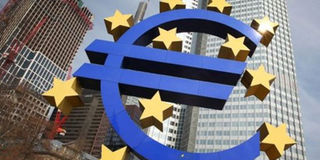Lessons from quantitative easing in Europe

Major shift. The headquarters of European Central Bank in Frankfurt, Germany. COURTESY PHOTO
What you need to know:
- While the economics of QE has been good and the politics bad, the whole episode has been awful for the Bundesbank.
- The main risk of QE is that too much money enters into circulation in the economy, thus resulting in high inflation.
With the European Central Bank having recently ended quantitative easing (QE), this is an appropriate time to reflect on the policy’s impact. Three conclusions seem obvious: the ECB’s asset purchases had important macroeconomic benefits; the political costs of QE were much greater than anyone expected; and the whole episode was truly awful for the Bundesbank.
By reducing the cost of bank loans through QE, the ECB encouraged lending to small firms and households across the eurozone. That gave an important boost to economic growth, leading to marked falls in unemployment and upward pressures on wage costs. Although headline inflation rose, underlying inflation remains weak, meaning that the ECB must maintain an expansionary monetary policy.
Furthermore, QE in Europe and elsewhere over the past decade has disproved a number of assertions about central-bank asset purchases. Chief among these is the oft-repeated claim that large-scale central-bank purchases of government bonds invariably results in high inflation.
Financial crises lead to a surge in demand for liquidity as financial institutions worry about the solvency of other players. Central banks can and should satisfy that demand by expanding their balance sheets, because not doing so can lead to a collapse in the money stock and a deep recession, as the US Federal Reserve demonstrated in the early 1930s.
Nor are such asset purchases illegal, as some insisted. The ECB, like the Fed and the Bank of Japan (BOJ), is not allowed to buy government bonds in primary markets. But many central banks have long relied on secondary-market bond purchases as their main means of conducting monetary policy. And in December 2018, the European Court of Justice ruled that such purchases do not violate EU law.
The ECJ also debunked the notion, popular in Germany, that QE is fiscal policy rather than monetary policy, and therefore off-limits for the ECB. But the Maastricht Treaty does not define monetary policy, which appears to be determined instead by what central banks actually do in practice. And here, the Fed, BOJ, and many other central banks have all conducted asset purchases in a way similar to the ECB.
But while QE has been effective and its legality is not in doubt, the ECB’s policies have triggered a huge political backlash by making almost all assets more expensive. At first glance, this might seem counter-intuitive. Higher housing prices lead to more building activity, which increases employment. Rising share prices boost the economy by shoring up the balance sheets and confidence of firms, households, and financial institutions. And lower bond yields – the corollary of rising bond prices – make finance cheaper and more available to companies and households alike.
But the asset-price boom also led to eye-popping increases in wealth for the richest few, which inflamed many Europeans who are still facing unemployment and painful austerity after the financial crisis. In addition, the decline in interest rates has provoked widespread protests by savers, particularly in Germany. This is puzzling, because one would expect savers to be pleased with rising asset prices. But OECD data show that German savers hold much less of their wealth in equities and much more in life-insurance products than their counterparts elsewhere in Europe. As a result, the stock-market boom has passed them by and the low-interest-rate environment has hurt their life-insurance plans. German savers blame the ECB for their difficulties, but the source of the problem seems to be their peculiar balance sheets.
The political backlash was best encapsulated in 2016 by former German finance minister Wolfgang Schäuble, who told an audience with reference to the Alternative für Deutschland party: “I told [ECB President] Mario Draghi: be very proud – you can attribute 50% of the results of a party that seems to be new and successful in Germany to the design of this policy.”
While the economics of QE has been good and the politics bad, the whole episode has been awful for the Bundesbank. In numerous speeches and interviews, its top brass have insisted that QE is unnecessary and raises obvious inflation risks, only to see inflation undershoot the ECB’s target year after year. Bundesbank officials also have argued that low interest rates will trigger financial instability, although this has not happened yet (and tight monetary policy can pose a similar risk). And they have doubted the legality of some of the ECB’s measures, although none of the legal challenges have been successful.
By sticking to its hardline views, despite being unable to persuade the ECB’s Governing Council to change tack on QE, the Bundesbank maneuvered itself into a corner and lost influence and standing. That is why the bank’s president, Jens Weidmann, is not seen as the leading candidate to be the next ECB president, despite his otherwise impressive grasp of economics, top-level experience, and excellent communication skills. The Bundesbank, it seems, has been the main loser from QE.
Stefan Gerlach is Chief Economist at EFG Bank in Zurich and a former Deputy Governor of the Central Bank of Ireland. He has also served as Executive Director and Chief Economist of the Hong Kong Monetary Authority and as Secretary to the Committee on the Global Financial System at the Bank for International Settlements.
ABOUT THE POLICY
Definition. Quantitative easing (QE) is the purchase of financial assets by a central bank. The central bank buys large amounts of financial assets, for example government bonds, from commercial banks and other financial institutions. By doing so, the central bank injects money into the economy that was not there before. Consequently, two things happen: there is more money in circulation in the economy, and interest rates decrease. The first effect is also the cause of the second.
Why implement QE? Increased liquidity and decreased interest rates are the reasons why a central bank implements quantitative easing. More money in the economy lowers the interest rate. A lower interest rate means it is cheaper for consumers, companies and the government to get access to capital, for example by obtaining a loan from the bank. This translates into more spending, which makes the economy move. The central bank can implement QE during a recession to stimulate the economy by increasing spending. What are the drawbacks? The main risk of QE is that too much money enters into circulation in the economy, thus resulting in high inflation. In simple words, the currency loses its value. An additional consequence of this is that people lose confidence in the economy. Another risk is that the ‘new money’ ends up in savings instead of being used in the economy.
The article is from Project Syndicate, 2019.




